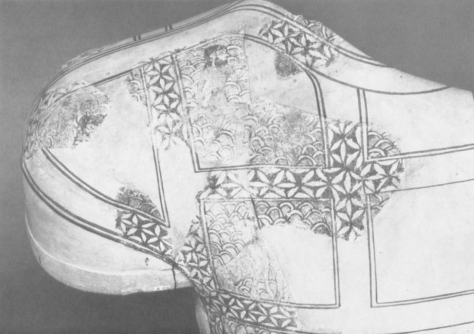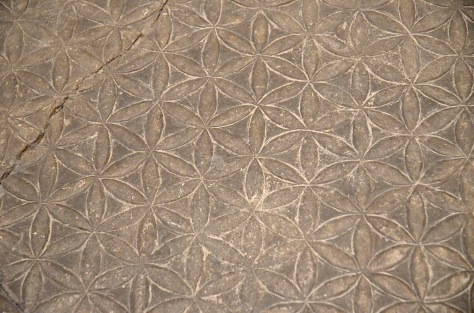List of Flowers
I have collected the following list of the FOL artifacts and ordered them by time from the oldest to the newest, undated items to the end of the list. I hope this list will help further investigators to find out more details of the objects, their origin and history that could reveal more about the history of the FOL itself. On picture descriptions I will tell shortly where objects can be found, their dating and sometimes other additional notes, links and references. It is very probable that more objects will be found in future. Think approximately half a million clay tablets that has been excavated from the Near East so far. Reading, cataloging and interpreting them is still considered to be in child steps. Many times more tablets are supposed to hide under the ground. Same applies to treasures in Egypt. Maybe thousands of relating objects are in private collections around the world waiting to see the daylight in uncertain future. Many, maybe most of the museums doesn’t have online picture collections of the objects. So only when individuals and researchers has this particular subject on their mind, they may pay attention to the FOL geometry in the artifacts. For example the goblet in the Medelhavsmuseet in Stockholm [item 14] was found only, when I realised week earlier that the FOL can be seen from the bottom or underside of the object. So when I saw attracting silver object in the museum glass vitrine, my first thing to do was to peek inside it. It was truly amazing to see the perfect FOL appearing there right under my eyes.
2000 – 0 BC
Golden rosettes [item 1]

Golden six-petal rosettes in the archaeological museum of Istanbul. Mycenae, Greece, 1600 BC. (Photo credit: Marko Manninen)
Cosmetic box [item 2]

A circular wooden cosmetic box with a swivel lid in the The Metropolitan Museum of Art in New York. Thebes, Egypt, 1492 – 1473 BC. Note resembling 12 petal rosette in the ivory box 1550 BC and 32 ray straight line star from the same period. (Photo credit: MET)
Silver goblet [item 3]

A silver goblet in the museum of Louvre. Underside of the object was unreachable for the visitors because the goblet stands on thick basement. But picture in the object description shows a full Flower of Life pattern in the bottom, very much similar to the silver goblet underside decoration in Stockholm [item 14]. Unfortunately only very little is known about the Marlik culture, but artifacts found from the royal cemetery shows excellence in the gold and silver metalwork. Marlik, northern Iran, 1400 – 1100 BC. (Photo credit: Marko Manninen)
Golden goblet [item 4]

Underside of a golden goblet in the museum of Louvre. Excavation report shows several artifacts having similar six-petal rosettes with surrounding petals under the goblets and beakers. Marlik, Iran, 1400 – 1100 BC. (Photo credit: © 1985 Photo RMN / Pierre et Maurice Chuzeville)
Ivory whorl [item 5]
An ivory whorl as seen in the British Museum. Cyprus, Greece, 1340 – 1050 BC. Note how peripheral petals are roughly made probably by a hand. This is a good example how precise much work it takes to draw the whole FOL pattern after the first seven simple circles.
Phoenician bowl [item 6]
A phoenician bowl in the Los Angeles County Museum of Art. 850 BC.
Idalion cup [item 7]

A cup with mythological scenes and flower of life pattern in the in its center visible in the Louvre museum. Idalion, Cyprus, 800 – 700 BC. (Photo credit: Public Domain)
Oval pyxis [item 8]

An oval pyxis with a base and a lid in the Iraq Museum, Baghdad. Nimrud, 800 – 700 BC. Note the object IM79513 that has similar, but badly cracked lid with the same geometric figure. (Photo source & credit: G. Herrmann & S. Laidlaw: Ivories from Nimrud VI)
Terracotta torso [item 9]

A cypriot terracotta torso in the British Museum. Salamis, Greece, 700 BC. (Photo source & credit: B.B. Shefton: Greek vases)
Ivory tusk [item 10]

A carved ivory tusk in the Iraq Museum, Baghdad. Nimrud, 800 – 700 BC. (Photo source & credit: G. Herrmann & S. Laidlaw: Ivories from Nimrud VI)
Ivory plague [item 11]

A fragment of an ivory plaque in the Iraq Museum, Baghdad. Nimrud, 800 – 700 BC. (Photo source & credit: G. Herrmann & S. Laidlaw: Ivories from Nimrud VI)
Bronze vessel [item 12]

A bronze vessel from the palace of Sennacherib. New York public library. Iraq, Nimrud, 700 BC. (Photo source & credit: NYPL Digital Library)
Stone floor sill [item 13]

A stone floor sill with a field of interlocking circles decoration from the palace of King Ashurbanipal. Visible in the Museum of Louvre. Related objects are also visible in the British Museum (BM 118910, BM 118913). The northern Iraq, 645 BC. (Photo credit: Marko Manninen)
Silver beaker [item 14]

An ancient Near East silver beaker bottom motif 600 – 500 BC. Object is in the Swedish Medelhavsmuseet. Kind staff from the museum also gave me this information: “The archived accession catalogue gives that it was received in 1980, probably through a certain O. Engkvist. There is also a comment in the margin: Prob Archaemenid, acc. To Vincent Pigott (Iran in the Near East), Prof pennsylvania, USA. Personal communication”. (Photo credit: Ove Kaneberg)
Ornament at the Temple of Osiris [item 15]

An ornament found at the stone slab in the Temple of Osiris. Claimed to have origins from 3000 BC (or even much older), but critical analysis gives dates from 400 BC – 200 BC to even after 1900 AD. Abydos, Egypt. (Photo credit: Ray Flowers)
Cave arches [item 16]

Chaitya arches in form of wood lattice patterns, floral patterns, berm-rail arches and a parapet with Assyrian pattern of a row of stepped triangles in the Buddhist temple of Pitalkhora. Maharashtra, India, 200 – 100 BC. (Photo credit: Vivek S. Kale)
Opus signinum [item 17]

Opus signinum (mosaic floor) of the Roman period house in the “city of charity”, Caminreal. Spain, 200 BC – 100 BC. (Photo source and credit: Jalme D.V. Redon)
Floor mosaic at Ephesus [item 18]

Floor mosaic that lays on the house 1a on the Curetes Street, near the Library of Celsus in the archaeological site of Ephesus, Turkey, 100 BC. (Photo credit: Ken & Nyetta)
Floor mosaic in Cyprus [item 19]

Mosaic floor ornament of late Hellenistic period at Roman agora, the archaeological site of Kourion in Cyprus. 75 – 50 BC. (Photo credit: Andrew Sweeney)
Floor mosaic [item 20]

Floor mosaic in the bathhouse at Lower Herodium built by Herod the Great, unearthed and visible at the National Museum of Israel. Israel, 20 BC. (Photo credit: © Shmuel Browns, used with permission)

Reblogged this on Twin Flames and commented:
The Flower of Life is the pattern of all life, a 2d representation of deep spiritual truths that transcend dimensions. Within it are contained the secrets to awareness, free energy, awakening, procreation, and creativity.
https://www.britishmuseum.org/research/collection_online/collection_object_details.aspx?objectId=368359&partId=1&place=33661&plaA=33661-3-1&page=1 A couple of hexafoils at the British from Sumer dating from 2500 aC.
Thanks for pointing out. It is fascinating to see, how common and old is this theme of serpents, scorpions and lions, chaos fighting with order, cosmos.